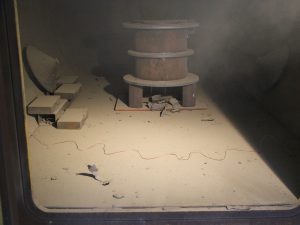CDP abrasives are customizable composite particles of metal oxides, fortified with the properties of diamond at the nanoscale, ranging in size from 10 nanometers to over 200 microns. The powders may be used as-is, or sieved and micronized, or acid digested to concentrate the diamond portion in an ultra-fine format. Our technology is a tool and our products are a resource that can be ordered in small research quantities or purchased in bulk.

Harnessing CDP technology to produce abrasive powders requires sophisticated steps with the right expertise, equipment and ingredients. We produce dry ice of a particular particle size, combine this with a proprietary amount of powdered reducing agents, pack the mixture into a consumable steel containment system, and detonate this inside of a huge blast chamber.
When CDP formulations detonate, about 50% – 70% of the explosive mass is converted into very fine powder comprised of about 90% – 95% metal oxides. The balance is carbon in various phases, including diamond.
After detonation we remove CDP abrasives from the blast chamber via vacuum extraction starting with the removal of airborne particles. Once the atmosphere has been adequately cleared, a worker enters the vessel to recover material that has settled on the ground. Our goal is to build a larger production vessel, whereby the powder is extracted in an automated manner.
| Our Formula | Resulting Powders | Products | Comments |
| CO2 + Mg | MgO, graphite, diamond | Mg-25, Mg-30, Mg-35, Mg-40 | Extractable nanodiamond |
| CO2 + Mg + Al | MgO, Al2O3, MgAl2O4, graphite, diamond | MgAl-35, MgAl-35A (Spinel) | Extraordinary abrasive powders |
| CO2 + Mg + Si | MgO, SiO2, Mg2SiO4, graphite, diamond | MgSi-3.2, MgSi-4.5, Mg-Silica | Silica/nanodiamond source |
CDP can mass-produce these materials with consistent physical properties, sieve them in tonnage quantities and ship to any location. Mass production reduces the overall production cost with the right production strategy, which means nanodiamond or a target product can be mass-produced most affordably from carbon dioxide and CDP.
CDP Abrasives serve as an excellent starting point from which superior manufacturing and abrasive products can be developed. Why? Nano-dispersion of diamond and hard structures within a softer abrasive like magnesium oxide, aluminum oxide, spinel and silica causes the abrasive properties of the bulk material to be more diamond-like for a fraction of the cost of a pure diamond product.
By controlling the types of reducing agents used in our process, we control the hardness of the non-carbon phase. By controlling the concentration of reducing agents in dry ice, we control the overall carbon yield, diamond yield in the carbon phase, and hardness of the graphite phase. This allows CDP to customize polishing products for any surface.
CDP Produces Polycrystalline Particles: That’s Good
In polishing applications, polycrystalline diamond outperforms monocrystalline diamond because of how these two particles break down differently during their use. Monocrystalline particles slowly flatten upon continued use, which progressively diminishes polishing capability over time. However, polycrystalline particles fracture upon continued use, revealing many sharp edges, which enables uninterrupted abrasive utility and therefore decreases overall polishing time.
Anything that saves time is worth money. However, polycrystalline diamond (produced through explosively shocking graphite) commands a much higher price than the monocrystalline variety, which limits its use to certain polishing applications only.
The particles that CDP produces are very affordable, hard, polycrystalline and totally customizable. CDP enables the production of diamond-like powders with that time-saving polycrystalline feature for a fraction of the cost. It makes more sense to leave the nanodiamond in and use the powder as-is to take advantage of the polycrystalline benefit.
Testing has determined that polycrystalline diamond-enhanced magnesium oxide (ex: Mg-35) with a hardness of 5.5 – 6.0 outperforms monocrystalline aluminum oxide, which should technically outperform magnesium oxide due to its superior hardness of 9. This observation is due to the polycrystalline complexity of CDP’s diamond-containing particles.